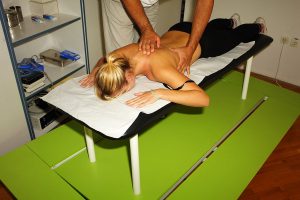The contemporary way of life, in which the upper part of the body, especially the neck and the shoulders, is passively overloaded for the most part of the day makes massages an everyday human necessity. Sitting for long periods of time and driving the car, as well as jobs due to which the neck and the shoulders lean forward for long periods of time, creates tension and muscle fatigue. Lactic acid, a product of metabolism, forms little lumps that are painful to touch. Hand massage, which can also be combined with ultrasound therapy. Manual medicine and traction increase elasticity of muscles and the range of the joint. Healthy people working in an office need as little as 15 minutes of expert neck, shoulders and back massage by a physiotherapist per week to prevent lumpy clusters (myogelosis) from developing. If we let them develop, muscles become painful, tensed and shortened. The range of spine movements is reduced, which leads to unbalanced overload and the damage of the soft tissue between the vertebrae, the discuses. I could compare this state with driving a car whose tires are not inflated enough. They are being used up unevenly and get damaged more quickly, just like the discuses! As opposed to the common belief, it is much better to get four fifteen minute massages per month than a single one hour massage at once. In addition to more and more popular massage tables, there are also very convenient kneeling chairs. They allow the physiotherapist an optimal approach to neck and shoulder muscles, with optimal relaxation of the patient’s head that is leaning on the cushion.
Regular professional physiotherapist massage is very beneficial and profitable because it allows better psychological and physical functioning throughout the entire week. When it comes to painful neck and lower back, and especially lumbar sciatic pain and cervicobrachial syndrome, it is the physiotherapist’s job to carefully determine which massage methods he or she should apply. Massage is, besides therapeutic exercises, very useful with asthma and bronchitis, as well as with a series of health conditions where it is applied less frequently. A special type of massage is acupuncture where we affect particular organs by stimulating certain points of the body. With reflex therapeutic massage methods via feet and hand palms we affect the targeted organs and organ systems. The feet encompass and represent all organs and organ systems and this method is excellent when it comes to prevention and therapy and is very comfortable for the patient.
Massage is a method that is probably most frequently used in physical medicine. In its gist, it refers to both hand and, albeit less frequent, machine manipulation of the muscle, skeletal and connective tissue for health benefits. It is a method that is often understated or overpraised, depending on the width and depth of the education of the person performing it. Today, physical therapists have a deep knowledge about the effects that can in that way yield the best possible improvement of the status in the sense of prevention or therapy. This knowledge is also significant because of the combination of massage with other methods. Patients or clients ask for massages when they feel joint stiffness that may or may not be connected to muscle pain. At the Tranfić Policlinic we found that the ideal prevention is the combination of back, neck and shoulder massage for 15 minutes combined with light 15 minute stretching. By repeating this procedure twice a month, we maintain the elasticity of muscles and the flexibility of joints. We prevent the development of myogelosis and spinal degenerative diseases. We create the conditions for efficient exercising and better functioning at one’s work place. We employ similar principles in therapy, of course, only when there are no side effects. This excellent massage technique that is based on high movement frequency allows us to, in a relatively short amount of time (15 minutes), at the Tranfić Policlinic, achieve a lot and include procedures such as the magnet, ultrasound, traction, manual medicine, kinesic-therapy and achieve the best results possible at a reasonable price. Massage is unavoidable for neck, thoracic spine, and shoulders therapy because the ration of power and muscle elasticity, as well as joint flexibility, creates the key of resistance to wrong attitudes, movements and stress.
An expert massage that comes “from the heart” is the most beneficial and profitable investment, while a message performed reluctantly, without “real passion,” is a waste of time and money, as well as an endangerment of your health!


